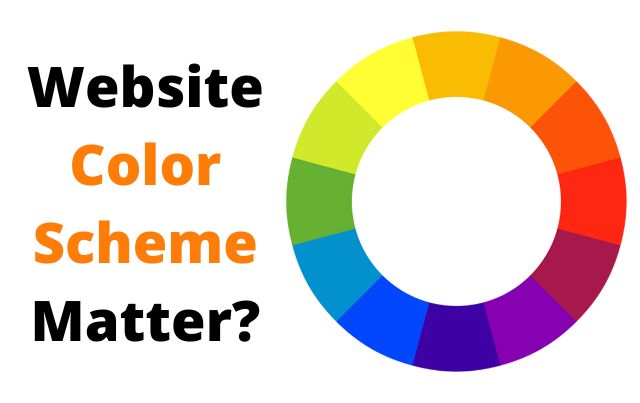Why does Choosing an Effective Website Color Scheme Matter?

Did you know that people make snap judgments about websites within 50 milliseconds? And that up to 94% of those judgments are based on color alone?
A website’s color scheme can have a profound impact on its overall look and feel. The right colors can convey a sense of professionalism, trustworthiness, and approachability, while the wrong colors can give visitors the impression that the site is amateurish or even untrustworthy. In addition to conveying messages about the site’s tone and personality, the color scheme can also affect a visitor’s mood and state of mind. Studies have shown that certain colors can help to stimulate positive emotions or encourage people to take action. For these reasons, it is important for website owners to carefully select a color scheme that will effectively support their goals for the site. With a little thought and planning, it is possible to create a website color scheme that is both visually appealing and functionally effective.
But with so many colors to choose from, how do you know which ones will work best for your website?
Here are a few things to keep in mind when choosing a color scheme:
1. Consider your audience:
Who are you trying to reach with your website? What kind of message do you want to send? Your color scheme should be reflective of that. The colors you use on your website have a big impact on how visitors perceive your brand. Each color conveys different emotions and messages. For example, blue is often associated with trustworthiness and dependability, while yellow is associated with optimism and cheerfulness. When choosing a color scheme for your website, it’s important to consider the emotions you want to communicate. Do you want visitors to feel calm and relaxed? Or do you want them to feel energized and excited? Once you’ve determined the mood you want to create, you can start selecting specific colors that will help achieve that goal. Keep in mind that it’s often best to stick with a limited palette of 2-3 colors to avoid overwhelming visitors with too much information. When used thoughtfully, color can be a powerful tool for creating an engaging and effective website.
2. Stick to a limited palette:
When it comes to website design, less is often more. It’s tempting to want to use every color under the sun, but too many colors can be overwhelming. A common mistake that designers make is trying to use too many colors. This can be overwhelming for users and make it difficult to focus on the content. Instead, stick to a limited palette of 3-5 colors. For example, you might use a light background with dark text, or vice versa. This will make your website more cohesive and easier to navigate. Choose colors that complement each other and avoid using too many shades of the same color. With a few strategic choices, you can create a website that is both stylish and easy to use.
3. Use contrasting colors:
This will make sure that your website is easy to read and navigate. As any web designer knows, choosing the right colors for your website is essential. Not only do they affect the overall look and feel of the site, but they can also impact usability. When it comes to creating an easy-to-use website, contrast is key. Using contrasting colors for your text and background can make a big difference in legibility. And when it comes to navigation, using contrasting colors for your links and active elements can help users quickly find what they’re looking for. By carefully considering color contrast, you can ensure that your website is both beautiful and user-friendly.
4. Avoid using similar colors:
While it may seem counterintuitive, using similar colors for website design can actually make it harder for users to navigate. Our brains are hardwired to see the contrast, and when two colors are too similar, they can blend together and create a “wash-out” effect. This can make it difficult to distinguish links, buttons, and other important elements on the page. In addition, using similar colors can also make the text more difficult to read. For example, don’t use two different shades of blue next to each other. This can make it difficult for people to distinguish between the two colors. So, if you’re looking to create a website that’s easy to use and navigate, be sure to use a variety of colors that contrast well with each other.
5. Use complementary colors:
Designers often use complementary colors when creating websites. Complementary colors are opposites on the color wheel, and they can create a striking contrast when used together. For example, website designers might use a blue background with orange text, or green background with purple text. This high contrast can be very effective in grabbing attention and making text easy to read. In addition, complementary colors can also help to create a feeling of energy and vibrancy on a website. When used judiciously, complementary colors can be a powerful tool for website design.
Meaning of Colors:
Color is one of the most important aspects of any design, and it can have a profound impact on the way people perceive your website. The colors you use can set the tone for your site and influence the way people interact with it. It’s important to choose colors carefully to ensure that they convey the right message and create the desired effect.
The meaning of colors can vary depending on culture, but there are some general associations that are widely accepted. For example, red is often associated with danger or warning, while green is associated with nature and relaxation. Blue is often seen as calming and serene, while yellow is associated with happiness and optimism.
When choosing colors for your website, it’s important to consider what message you want to communicate. Do you want your site to be exciting and energetic? Or calm and serene? The colors you choose should reflect the overall tone of your website.
Red:
Red represents energy, excitement, love, passion, etc. Brands like Coca-Cola, LEGO, and Nintendo have a red color to represent their identity and to psychology put an impact on people with the color for what they’re about.
Yellow:
Yellow represents Optimism, Joy, Fresh, etc. Brands like Subway, McDonald’s, National Geographic, Best Buy, etc. have a yellow color to represent their identity and to psychology put an impact on people with the color for what they’re about.
Blue:
Blue represents Clarity, Calm, Trust, Security, etc. Brands like HP, Facebook, Oral-B, NASA, etc. have a blue color to represent their identity and to psychology put an impact on people with the color for what they’re about.
Green:
Green represents Nature, Relaxation, Peaceful, Hopeful, Healing, etc. Brands like Animal Planet, Tropicana, Whole Foods, etc. have a green color to represent their identity and to psychology put an impact on people with the color for what they’re about.
Purple:
Purple represents Glamor, Royalty, Luxury, Creativity, etc. Brands like Yahoo, Barbie, Cadbury, etc. have purple color to represent their identity and to psychology put an impact on people with the color for what they’re about.
Grey:
Grey represents Respect, Wisdom, Modern, Intelligent, etc. Brands like Apple, Wikipedia, Honda, etc. have a grey color to represent their identity and to psychology put an impact on people with the color for what they’re about.
Black:
Black represents Powerful, Bold, Elegant, Luxurious, etc. Brands like Puma, Nike, etc. have Black color to represent their identity and to psychology put an impact on people with the color for what they’re about.
The Psychology of Color:
Color is a powerful tool that can be used to influence the way people think, feel, and behave. The psychology of color is a branch of study that looks at how different colors can affect our moods, emotions, and behaviors.
Studies have shown that color can have a profound impact on the way we think, feel, and behave. For example, research has shown that the color red can increase our levels of anxiety and stress, while blue can help to calm us down.
The bottom line is that color is a powerful tool that should be used carefully to create the desired effect. When choosing colors for your website, be sure to consider the meaning of colors and the way they might influence the way people interact with your site.
By following these tips, you can choose a color scheme that will help make your website more effective. And that’s sure to please your visitors!





